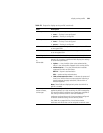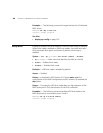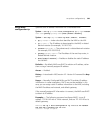
set ap bias 367
set ap bias Changes the bias for a MAP. Bias is the priority of one WX over other WX
switches for booting and configuring the MAP.
Syntax —
set ap ap-number auto bias {high | low}
ap ap-number — Index value that identifies the MAP on the WX.
ap auto — Configures bias for the MAP configuration profile. (See
set ap auto on page 362.)
high — High bias.
low — Low bias.
Defaults — The default bias is high.
Access — Enabled.
History —Introduced in MSS Version 3.0. Option auto added for
configuration of the MAP configuration profile. Version 6.0 removed the
dap option.
Usage — High bias is preferred over low bias. Bias applies only to WX
switches indirectly attached to the MAP through an intermediate Layer 2
or Layer 3 network. A MAP always attempts to boot on MAP port 1 first,
and if an WX is directly attached on MAP port 1, the MAP always boots
from it.
If MAP port 1 is indirectly connected to WX switches through the
network, the MAP boots from the WX with the high bias for the MAP. If
the bias for all connections is the same, the MAP selects the WX that has
the greatest capacity to add more active MAPs. For example, if a MAP is
dual homed to two WX4400 wireless LAN switches, and one of the
switches has 50 active MAPs while the other WX has 60 active MAPs, the
new MAP selects the WX that has only 50 active MAPs.
If the boot request on MAP port 1 fails, the MAP attempts to boot over its
port 2, using the same process described above.
MAP selection of a WX is sticky. After a MAP selects a WX to boot from,
the MAP continues to use that WX for its active data link even if another
switch configured with high bias for the MAP becomes available.


















